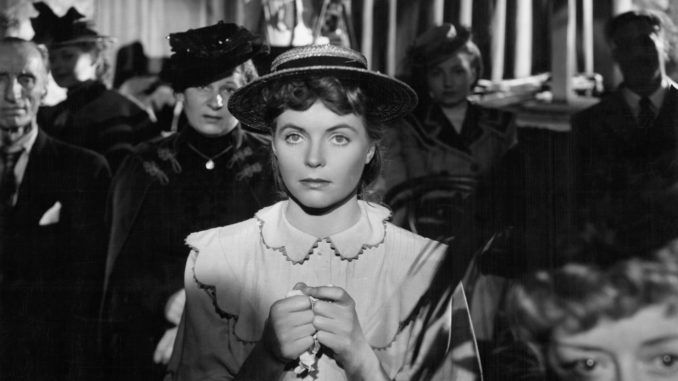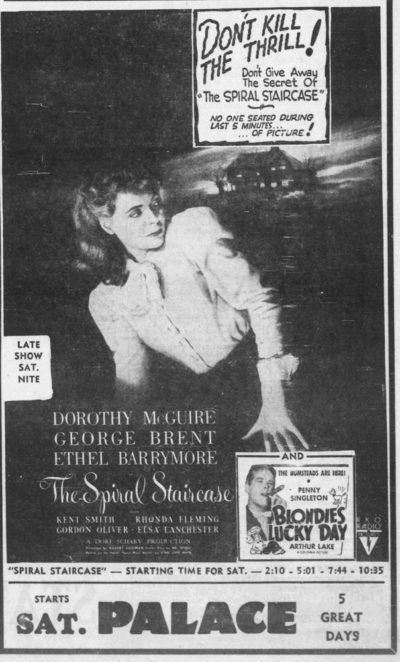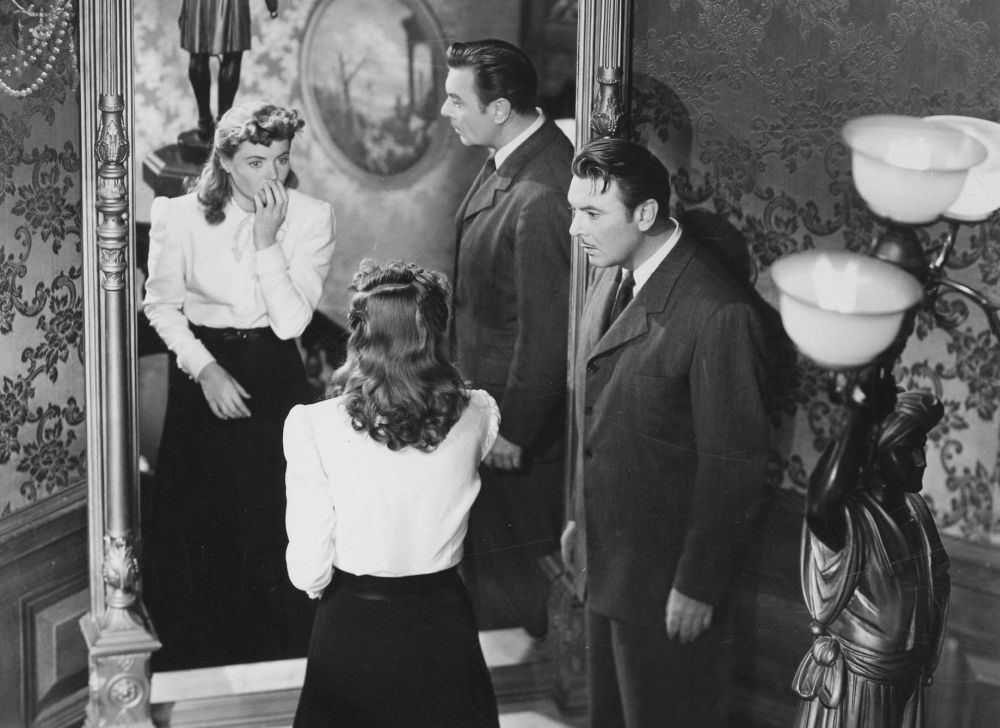
Rating: B
Dir: Robert Siodmak
Star: Dorothy McGuire, George Brent, Ethel Barrymore, Kent Smith
As we head back from the painfully lean years of the late forties, it feels like things might be improving – albeit slightly. A whole twenty-six features released this year are identified by the IMDb as horror, ten of which have more than a thousand ratings. That’s a lot better than we’ve seen of late. I opted to dismiss the highest-rated one, The Time of Their Lives. It’s another damn Abbott and Costello comedy with vaguely spooky overtones: “A mansion haunted by prankish ghosts,” according to the synopsis. Nah, I’m good. That decision proved wise, because this is certainly a better fit. Indeed, you could make an argument it is the first slasher film. I wouldn’t, personally, go quite that far. And, yet…
This is based on a 1933 novel Some Must Watch by Ethel Lina White, and was remade in 1975, also as The Spiral Staircase, with Jacqueline Bisset and Christopher Plummer. There have been two TV versions, most recently in 2000 starring, um, Nicollette Sheridan – won’t be chasing that up – and a couple of radio adaptations too. I’m a little surprised nobody has tried a remake recently: it has potential. This takes place in 1906 Vermont (an era when brandy and ether were, apparently, cure-alls!), and unfolds over the course of one day and night. It begins with the discovery of a murder victim in her room. This is the third such killing in short order, all the victims being young women with… deficiencies. This is not good news for our heroine, Helen (McGuire), who has been struck mute since the trauma of her parents’ death.
 She heads back from town to the mansion where she’s a caregiver to the spectacularly cantankerous and bedridden matriarch of the Warren family (Barrymore). Also resident there, or popping in and out, are her two sons, Albert (Brent) and Steven, physician Dr. Parry (Smith), the local constable, and various other servants, including the Bride of Frankenstein herself, Elsa Lanchester, as cook Mrs. Oates. The constable pops in to warn them the killer is believed to be in the area. But we know, from a figure spying on Helen, that the murderer is already inside the house. It is, naturally, a dark and stormy night, as the body-count increases, eventually forcing Helen into a battle for her survival.
She heads back from town to the mansion where she’s a caregiver to the spectacularly cantankerous and bedridden matriarch of the Warren family (Barrymore). Also resident there, or popping in and out, are her two sons, Albert (Brent) and Steven, physician Dr. Parry (Smith), the local constable, and various other servants, including the Bride of Frankenstein herself, Elsa Lanchester, as cook Mrs. Oates. The constable pops in to warn them the killer is believed to be in the area. But we know, from a figure spying on Helen, that the murderer is already inside the house. It is, naturally, a dark and stormy night, as the body-count increases, eventually forcing Helen into a battle for her survival.
There’s a fair amount of overlap in staff between this and Cat People, another RKO production from four years earlier. Admittedly, this was considerably more expensive, with five to six times the budget, but both have music composed by Roy Webb (I think I heard some theremin on the soundtrack, always a pleasure), and Kent Smith as the romantic lead. However, the biggest contribution is cinematographer Nicholas Musuraca. He does tremendously atmospheric work here, especially given the great bulk of the action takes place in a single location, the Warren manor. There are some brilliant, almost Hitchcockian touches which seem decades ahead of their time, such as seeing the victims reflected in the killer’s eyes (actually director Siodmak’s were used) , and every shot seems to be filled with ominous shadows, potentially hiding a threat to Helen.
The performances, especially from female leads McGuire and Barrymore, are also good. As the speechless heroine, McGuire has to do a lot of physical acting, and it’s impressive that the film rarely has her resort to cop-outs like writing stuff down to communicate. I will admit, I did laugh when she tried to call for help on the phone, which went as well as you would expect. Duh, dumb much? It’s likely not much of a spoiler to say that the events of the night manage to cure Helen of her affliction, better than all of Dr. Parry’s ministrations managed. Who needs psychotherapy, when you can just have a madman stalking you, burbling on about how he wants to “dispose of the weak and imperfects of the world”?
Ethel Barrymore, who was the great-aunt of Drew, is also wonderful , especially when spitting venom at her much-despised nurse. She’s another grande dame of the stage, who had returned after a lengthy absence to slumming it in Hollywood – a little like Edith Evans in The Queen of Spades. Her performance was good enough to get an Academy Award nod for Best Supporting Actress at the 1947 Oscars. While losing to Anne Baxter, she is plausibly the first actress honoured for her role in a horror film. [She was nominated in the same category four times in a six-year period, winning for None But The Lonely Heart] She delivers some great foreshadowing there: it’s a moment where I thought, “I wonder if that’ll be significant?”, then completely forget about things until, indeed, it proved very significant.
 Admittedly, this is not just a horror film, and was called a “mystery romance” at the time. It is inevitably going to seem tame by modern standards, particularly in its lack of on-screen death, and is a Gothic mystery as much. But you can definitely see moments and elements which could have come from the subsequent work of Mario Bava or Dario Argento, over in Italy. Remaining in the US, the close-ups of the killer’s eye were recycled in Bob Clark’s Black Christmas, and its killer POV may have influenced John Carpenter in Halloween. It was advertised (above) with the gimmick that nobody would be allowed in during the climax, an idea recycled with greater emphasis for Psycho, where no-one was allowed in after the start.
Admittedly, this is not just a horror film, and was called a “mystery romance” at the time. It is inevitably going to seem tame by modern standards, particularly in its lack of on-screen death, and is a Gothic mystery as much. But you can definitely see moments and elements which could have come from the subsequent work of Mario Bava or Dario Argento, over in Italy. Remaining in the US, the close-ups of the killer’s eye were recycled in Bob Clark’s Black Christmas, and its killer POV may have influenced John Carpenter in Halloween. It was advertised (above) with the gimmick that nobody would be allowed in during the climax, an idea recycled with greater emphasis for Psycho, where no-one was allowed in after the start.
Siodmak was no journeyman director either. He was Oscar nominated the same year, for his classic noir film, The Killers, and had previous horror experience, in 1943’s Son of Dracula. He keeps the tension high from beginning to end, although it’s perhaps not too difficult to work out who the killer is. I was kinda hoping it would turn out to be Helen – taking out frustration for her own disability on other women suffering similarly. While much of this has hardly aged at all, going there would definitely have been a stretch for Hollywood in the forties. It remains a solid and satisfying work, among the most consistently engrossing works we’ve seen this month.
This article is part of our October 2025 feature, 31 Days of Vintage Horror.
